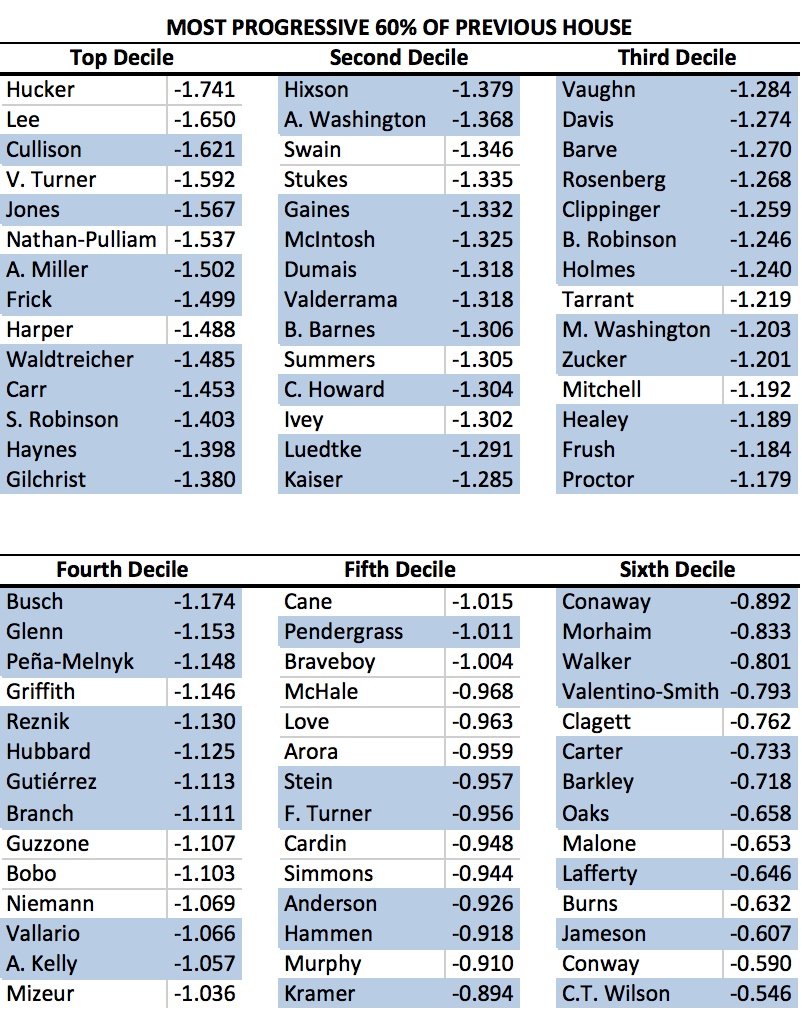
Blue Indicates Reelected Delegate
The above table contains a list of the 84, or 60 percent, most progressive delegates going into the 2014 elections, according to Boris Shor and Nolan McCarty’s measure of state legislator ideology. Remember that the lower the score (i.e. the more negative or left on the number line), the more progressive the legislator.
Interpreting the Scores
Two key caveats need to be remembered when interpreting the table. First, two legislators–David Fraser-Hidalgo and Steven Arentz–were appointed too recently to have scores and are not included. (Unlike for the Senate, scores are also unavailable for newly elected legislators; most new senators were former delegates.)
Second, the the tradition of the House is that legislators vote with their committee on the key second reading of bills that have emerged from their committee. The basic rationale is that legislators should not have a second bite at the apple and go along with the results of their committee. Adherence to this tradition would alter a legislator’s score if they would have otherwise voted differently.
As a rough cut, the top four deciles, or 40% of the House, are all solid progressives or liberals (pick your favorite) on most issues. The fifth and sixth deciles, who formed the middle 20% ideologically of the old House, were more center left with legislators becoming more moderate as the scores get closer to zero.
Departure of Moderate Democrats
Liberalism appears somewhat related to the likelihood that a legislator from the old House will return in the new one. Consider that 11, or 26%, of the 42 most progressive legislators (i.e. the top three deciles) will not return in 2015. But among the 42 next most progressive legislators (i.e. the fourth through sixth deciles), 17, or 40%, will not serve in the new House.
(The numbers indicate the same conclusion if one divides the two groups between the third and fourth deciles. In the top four deciles, 29% of the 56 won’t return, as compared to 43% of the 28 delegates in the fifth and sixth most progressive deciles.)
The 13 most moderate Democrats are not shown in the table. Perhaps most tellingly, 8 or 62% of them will not be coming back. And none left because they moved to the Senate. As detailed in Friday’s post, many lost reelection to Republicans in the “Massacre of the Moderates.”
The Speaker and His Caucus
Notice that Speaker Michael Busch was slightly left of center in his old caucus (remember 13 Democrats are not in the tables). He seems likely to be slightly right of the center in his new caucus, as more moderates were defeated. Moreover, it seems quite possible that newly elected legislators will be more left wing than the delegates who preceded them in office.
The Most Progressive Returning Legislators
Interestingly, the three most progressive returning legislators according to the Shor-McCarty measure sat in the Senate: (1) Rich Madaleno, (2) Paul Pinsky, and (3) Roger Manno. However, the next two were members of the House: (4) Susan Lee, and (5) Bonnie Cullison, though Lee is moving from the House to the Senate when the new General Assembly convenes.









